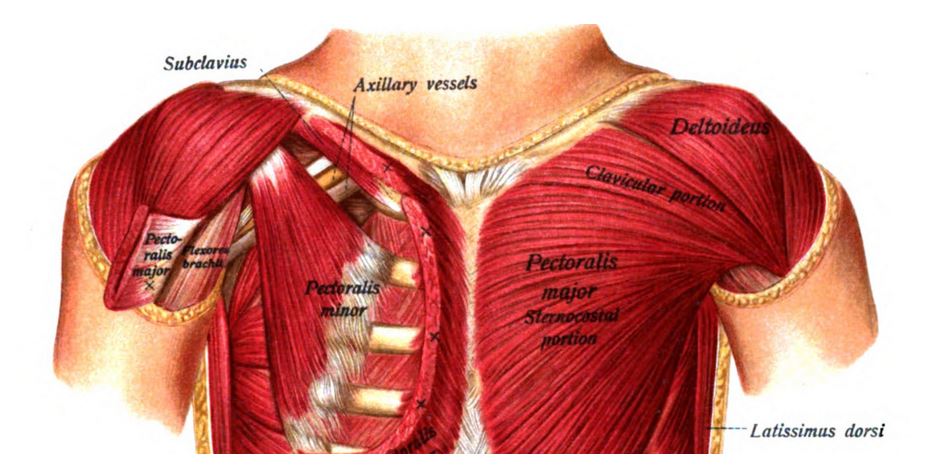Bench Press Around Cranky Arms and Shoulders
Today is day one of a vaction back home to British Columbia to see my folks and brothers. As such, today I have a guest post from Sam Spinelli, a fellow Edmontonian who is finishing up a doctor of physical therapy degree. Enjoy.
The bench press is one of the most famous lifts, one in which many people compare themselves with a simple statement – “how much you bench” – upon first introduction.
While the bench press is so loved, it is also notorious for people having issues with it. Assuming your mechanics are great, sometimes things just don’t go the way you hoped and an injury pops up. With the bench press there are a number of possible ones related to the shoulder, the elbow, the wrist, plus all of the muscles involved benching.

There’s not a lot of worse things than when you come into the gym, feeling like a boss, lay down to crush some weight, and it just starts to go down hill as you begin repping out the bar.
Things just aren’t feeling right; in fact, you might even have some pain from it. You remember that the last time you were benching it didn’t really feel this way, but you did push it pretty hard.
What do you do here when things aren’t quite feeling right? One option would be that you could pack up your things and go home. I’ll assume most of the people reading this would prefer to avoid that option like the plague. For most people passionate about training, packing up and leaving is not a legitimate option.
Another option would be to ignore the pain/sensitivity and just push through. This option is probably the one where you end up hurting yourself though, making you take steps back in training. That obviously does not sound like a good option either, so where does that leave us?
We have a third option – modify training for success. How can we do that? Depending upon what sort of pain you’re experiencing, we can work to train around it while also potentially working to fix it. We’ve categorized the most common issues with benching below and discussed strategies to keep training while also addressing the actual issue.
Pec/shoulder pain in the bottom of the movement
If you are dealing with a shoulder or pec issue while benching, it is most often associated with the bottom position of the bench press. If this is some sort of muscle strain, our goal should be to avoid irritating it while allowing it to recover. This doesn’t mean we have to stop training, but it does mean training will need to shift focus. Utilizing a variation other than the traditional bench press should allow us to keep lifting without pissing it off.
- Board/roller bench press
Using a board variation will reduce the range of motion you are working with, in particular keeping you in the top half of the bench press. The bottom portion of the bench press is the most “provocative” as it puts the shoulder into a position where it can push the humeral head forward and upward – irritating other structures. By using the boards/roller we can decrease the stress to those structures and give them a time to calm down while still getting our training effect in.
- Floor press
Working in a similar fashion to the above version, but we are also now providing some additional support to the shoulders by broadening our back support. This option for many people can actually feel better on the pecs and shoulders than the board/roller option.
- DB bench press
For some individuals having the hands fixed as they are with the barbell bench press can irritate the shoulders. Using a neutral grip barbell is one option – but not that available to most people. In contrast, we can use dumbbells and play with our grip position to eliminate the irritation and keep benching.
Keep in mind if this is some sort of muscle strain, we want to focus on minimizing how we are irritating it and allow it to recover – check out this article for more in depth knowledge on muscle strain recover tips.
Elbow pain
The bench press is very demanding on a lot of the structures of the elbow. This can be really compounded if doing other movements that can stress the elbow, such as low bar squats. Depending upon the exact issue you’re dealing with, there are a few different things we can do to try and work on it.
- Achy triceps
The bench uses the triceps big time. For some people this can cause issues with them where you start to get pain right at the insertion of the triceps on the elbow. Utilizing strategies described above might work, particularly the DB bench press option. However, if this isn’t a muscle strain, then we are going to want to take a different approach towards the triceps rehab. Here we are going to focus on getting the muscles more tolerant to working. This can be done a number of ways, but we will focus on two of the best ways.
- Metabolite/pump work
- Using something like a tricep pressdown we are able to focus in on the triceps and do some high volume work where we get a ton of blood pumping into the area. This can help to bring in good nutrients to the area and clear out fluid.
- At the end of your session consider picking a light weight and pumping out 30-50 reps at a time.
[Note from Dean: This is also an awesome time to try using something like blood flow restriction training to build up more metabolic stress with lighter weights.]
- Heavy eccentric resistance
- At first thought using heavy resistance might sound counter intuitive. However, there is a great deal of research focused in what we call tendinopathy (conditions affecting the tendon) and it has shown that using heavy resistance – particularly when done with a slower tempo – can help to get the tendon strong and resilient to stress, reducing symptoms.
- At the end of your session, using an exercise like the tricep pressdown we can work on overloading the muscle by using a heavier eccentric motion. To do this, we use two arms for the concentric, then transition the weight to a single arm and do the eccentric. This can do wonders for those dealing with tendon issues.
- Lateral elbow issues
The lateral elbow can get cranky in a lot of lifters. Whether it be due to being put in an awkward position – such as low bar or front squatting – or due to all of the volume we do gripping, many individuals experience this issue. Utilizing a similar strategy to above, we can work to modify exercises to alleviate stress on the elbow while we can work on it getting better.
- Metablite/pump work
- Doing movements like reverse curls or finger extensions, we are able to hammer out a ton of reps and get blood flowing through this area.
- At the end of your session consider grabbing a lighter barbell and pumping out 30-50 reps of reverse curls.
- Heavy eccentric resistance
- We gave you the run down on these already, and for this part of the body the research is incredibly supportive of this approach.
- Here is a great example for it using the wrist extension movement with a dumbbell.
This list should cover the vast majority of issues people deal with during the bench press. However, if you are still experiencing issues – particular with your shoulders – you may need to do a larger training revamp. Check out this article for some guidelines on getting healthy shoulders if they are not responding to just exercise modification.
Move well, lift heavy, stay healthy,
Sam Spinelli
